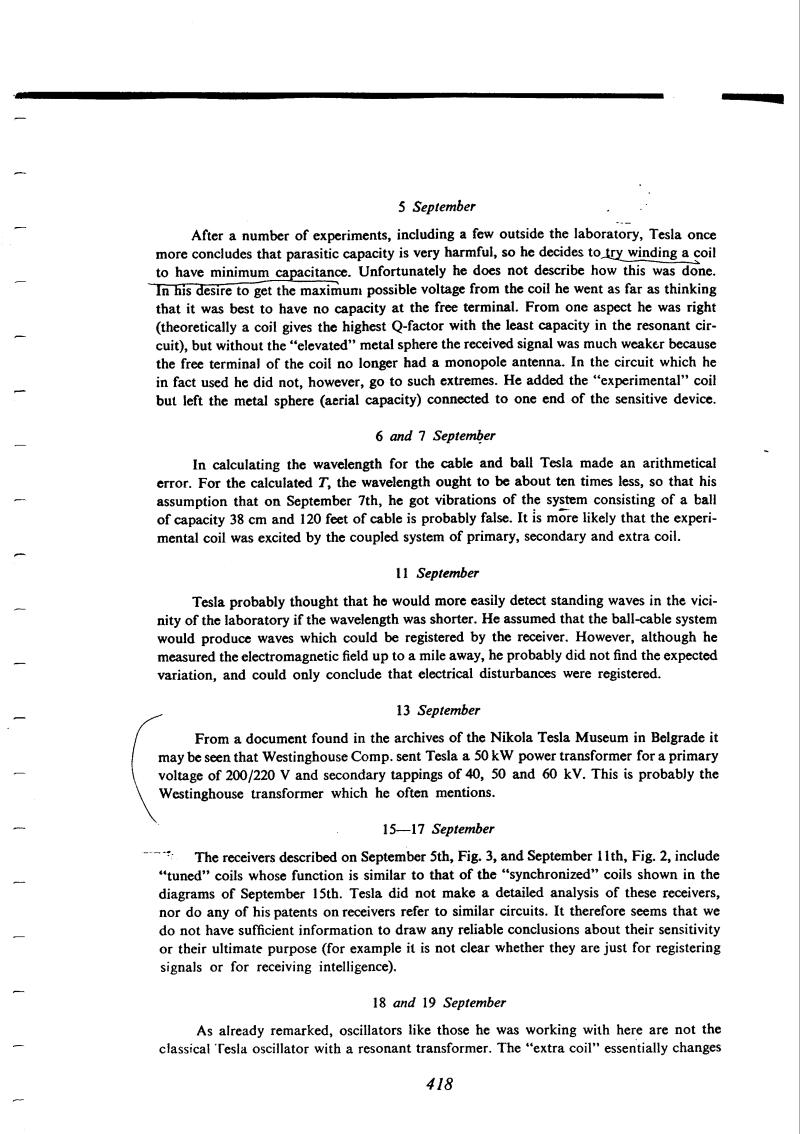
Nikola Tesla Books
September 5
After a number of experiments, including a few outside the laboratory, Tesla once more concludes that parasitic capacity is very harmful, so he decides to try winding a coil to have minimum capacitance. Unfortunately he does not describe how this was done. In his desire to get the maximum possible voltage from the coil he went as far as thinking that it was best to have no capacity at the free terminal. From one aspect he was right (theoretically a coil gives the highest Q-factor with the least capacity in the resonant circuit), but without the âelevatedâ metal sphere the received signal was much weaker because the free terminal of the coil no longer had a monopole antenna. In the circuit which he in fact used he did not, however, go to such extremes. He added the âexperimentalâ coil but left the metal sphere (aerial capacity) connected to one end of the sensitive device.
September 6-7
In calculating the wavelength for the cable and ball Tesla made an arithmetical error. For the calculated T, the wavelength ought to be about ten times less, so that his assumption that on September 7th, he got vibrations of the system consisting of a ball of capacity 38 cm and 120 feet of cable is probably false. It is more likely that the experimental coil was excited by the coupled system of primary, secondary and extra coil.
September 11
Tesla probably thought that he would more easily detect standing waves in the vicinity of the laboratory if the wavelength was shorter. He assumed that the ball-cable system would produce waves which could be registered by the receiver. However, although he measured the electromagnetic field up to a mile away, he probably did not find the expected variation, and could only conclude that electrical disturbances were registered.
September 13
From a document found in the archives of the Nikola Tesla Museum in Belgrade it may be seen that Westinghouse Comp. sent Tesla a 50 kW power transformer for a primary voltage of 200/220 V and secondary tappings of 40, 50 and 60 kV. This is probably the Westinghouse transformer which he often mentions.
September 15-17
The receivers described on September 5th, Fig. 3, and September 11th, Fig. 2, include âtunedâ coils whose function is similar to that of the âsynchronizedâ coils shown in the diagrams of September 15th. Tesla did not make a detailed analysis of these receivers, nor do any of his patents on receivers refer to similar circuits. It therefore seems that we do not have sufficient information to draw any reliable conclusions about their sensitivity or their ultimate purpose (for example it is not clear whether they are just for registering signals or for receiving intelligence).
September 18-19
As already remarked, oscillators like those he was working with here are not the classical Tesla oscillator with a resonant transformer. The âextra coilâ essentially changes
418

